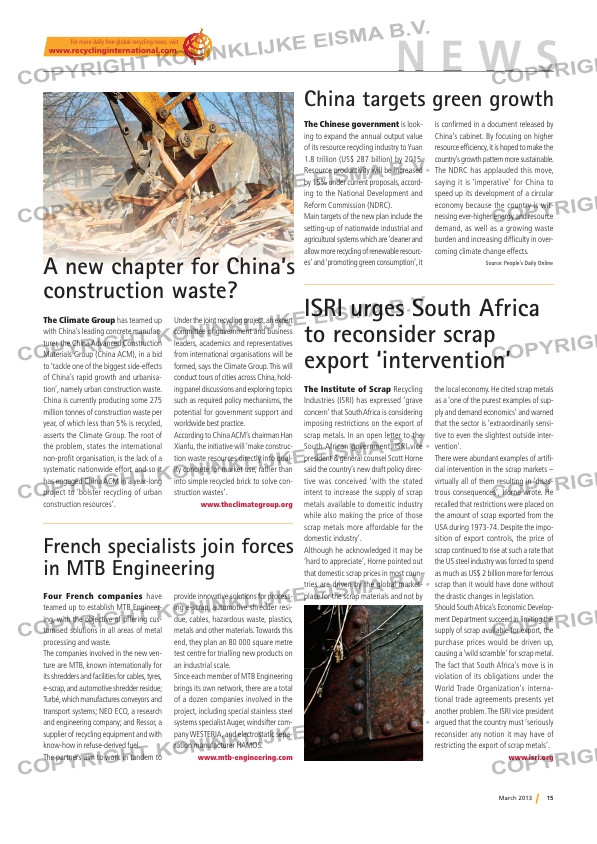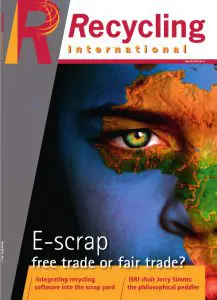Page 15 from: March 2013

N E W S
15March 2013
For more daily free global recycling news, visit
www.recyclinginternational.com
The Climate Group has teamed up
with China’s leading concrete manufac-
turer, the China Advanced Construction
Materials Group (China ACM), in a bid
to ‘tackle one of the biggest side-effects
of China’s rapid growth and urbanisa-
tion’, namely urban construction waste.
China is currently producing some 275
million tonnes of construction waste per
year, of which less than 5% is recycled,
asserts the Climate Group. The root of
the problem, states the international
non-profi t organisation, is the lack of a
systematic nationwide effort and so it
has engaged China ACM in a year-long
project to ‘bolster recycling of urban
construction resources’.
Under the joint recycling project, an expert
committee of government and business
leaders, academics and representatives
from international organisations will be
formed, says the Climate Group. This will
conduct tours of cities across China, hold-
ing panel discussions and exploring topics
such as required policy mechanisms, the
potential for government support and
worldwide best practice.
According to China ACM’s chairman Han
Xianfu, the initiative will ‘make construc-
tion waste resources directly into qual-
ity concrete for market use, rather than
into simple recycled brick to solve con-
struction wastes’.
www.theclimategroup.org
A new chapter for China’s
construction waste?
Four French companies have
teamed up to establish MTB Engineer-
ing, with the objective of offering cus-
tomised solutions in all areas of metal
processing and waste.
The companies involved in the new ven-
ture are MTB, known internationally for
its shredders and facilities for cables, tyres,
e-scrap, and automotive shredder residue;
Turbé, which manufactures conveyors and
transport systems; NEO ECO, a research
and engineering company; and Ressor, a
supplier of recycling equipment and with
know-how in refuse-derived fuel.
The partners aim to work in tandem to
provide innovative solutions for process-
ing e-scrap, automotive shredder resi-
due, cables, hazardous waste, plastics,
metals and other materials. Towards this
end, they plan an 80 000 square metre
test centre for trialling new products on
an industrial scale.
Since each member of MTB Engineering
brings its own network, there are a total
of a dozen companies involved in the
project, including special stainless steel
systems specialist Auger, windsifter com-
pany WESTERIA, and electrostatic sepa-
ration manufacturer HAMOS.
www.mtb-engineering.com
French specialists join forces
in MTB Engineering
The Chinese government is look-
ing to expand the annual output value
of its resource recycling industry to Yuan
1.8 trillion (US$ 287 billion) by 2015.
Resource productivity will be increased
by 15% under current proposals, accord-
ing to the National Development and
Reform Commission (NDRC).
Main targets of the new plan include the
setting-up of nationwide industrial and
agricultural systems which are ‘cleaner and
allow more recycling of renewable resourc-
es’ and ‘promoting green consumption’, it
is confi rmed in a document released by
China’s cabinet. By focusing on higher
resource effi ciency, it is hoped to make the
country’s growth pattern more sustainable.
The NDRC has applauded this move,
saying it is ‘imperative’ for China to
speed up its development of a circular
economy because the country is wit-
nessing ever-higher energy and resource
demand, as well as a growing waste
burden and increasing diffi culty in over-
coming climate change effects.
Source: People’s Daily Online
China targets green growth
The Institute of Scrap Recycling
Industries (ISRI) has expressed ‘grave
concern’ that South Africa is considering
imposing restrictions on the export of
scrap metals. In an open letter to the
South African government, ISRI vice
president & general counsel Scott Horne
said the country’s new draft policy direc-
tive was conceived ‘with the stated
intent to increase the supply of scrap
metals available to domestic industry
while also making the price of those
scrap metals more affordable for the
domestic industry’.
Although he acknowledged it may be
‘hard to appreciate’, Horne pointed out
that domestic scrap prices in most coun-
tries are driven by the global market-
place for the scrap materials and not by
the local economy. He cited scrap metals
as a ‘one of the purest examples of sup-
ply and demand economics’ and warned
that the sector is ‘extraordinarily sensi-
tive to even the slightest outside inter-
vention’.
There were abundant examples of artifi –
cial intervention in the scrap markets –
virtually all of them resulting in ‘disas-
trous consequences’, Horne wrote. He
recalled that restrictions were placed on
the amount of scrap exported from the
USA during 1973-74. Despite the impo-
sition of export controls, the price of
scrap continued to rise at such a rate that
the US steel industry was forced to spend
as much as US$ 2 billion more for ferrous
scrap than it would have done without
the drastic changes in legislation.
Should South Africa’s Economic Develop-
ment Department succeed in limiting the
supply of scrap available for export, the
purchase prices would be driven up,
causing a ‘wild scramble’ for scrap metal.
The fact that South Africa’s move is in
violation of its obligations under the
World Trade Organization’s interna-
tional trade agreements presents yet
another problem. The ISRI vice president
argued that the country must ‘seriously
reconsider any notion it may have of
restricting the export of scrap metals’.
www.isri.org
ISRI urges South Africa
to reconsider scrap
export ‘intervention’
RI_2-NEWS.indd 15 06-03-13 09:35



